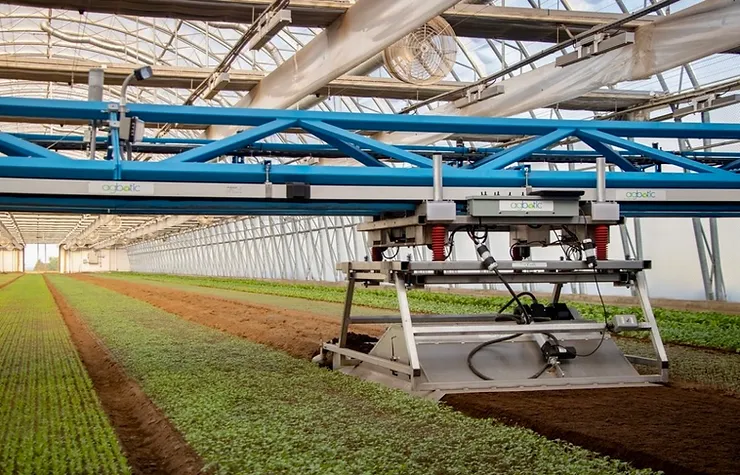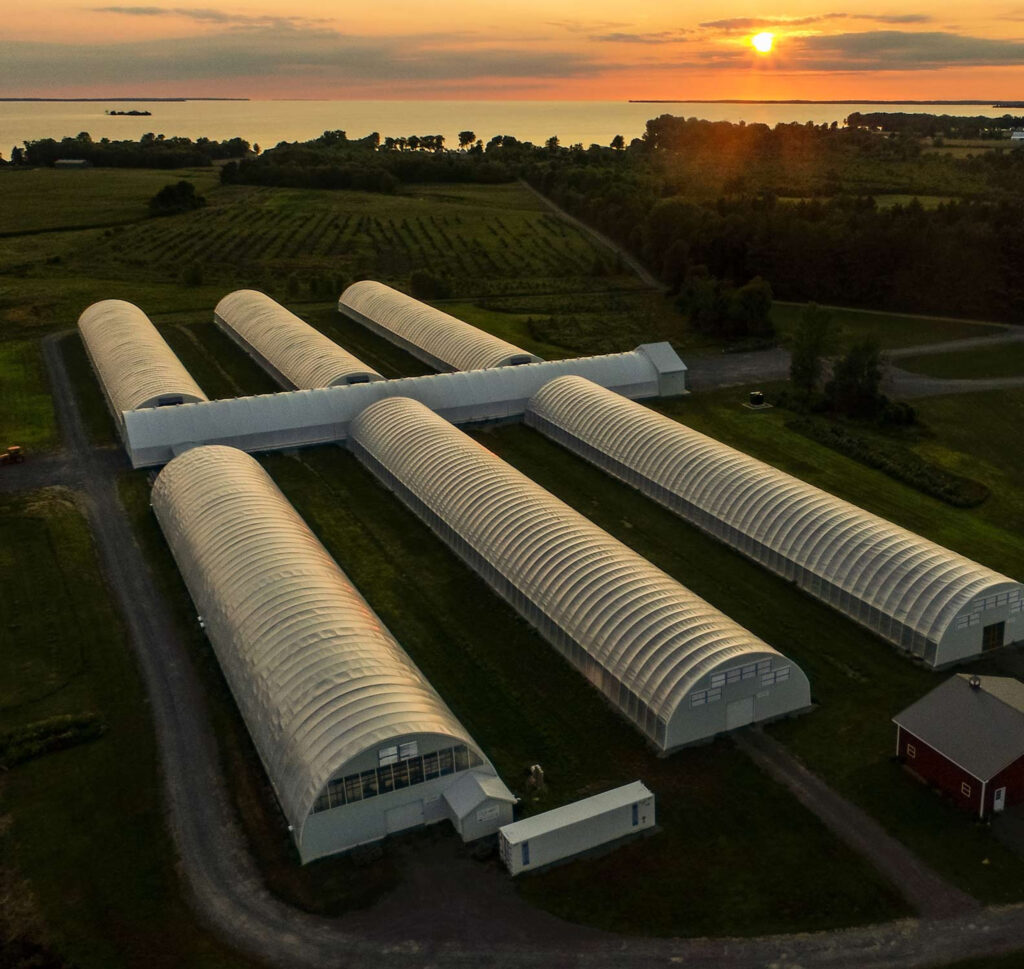Forms of Controlled Environment Agriculture can be used to store carbon and save the planet, one farm in Upstate New York is doing just that.
By: Lelan O’Brien

https://www.agbotic.com/post/sustainablefarming
Over the past few years, billions of dollars have been invested in a growing sector of agriculture called “Controlled Environment Agriculture” (CEA). Broadly, CEA includes farming models such as vertical farming, aquaponics, or other forms of indoor greenhouse-style farms. Oftentimes CEA is perceived to be the future of agriculture, with cheap produce due to relatively stable yields with little water use compared to other traditional farming models. CEA also often allows farmers to grow foods closer to consumers, reducing food miles (the distance it takes for food to reach consumer’s tables) which in turn greatly reduces the environmental impact farming can have. As the amount of arable land in the world decreases and our population only continues to increase, something has to be done so we can feed our future generations. As much as environmentalists would love to point at CEA for the solution to this problem, the ever so popular CEA comes with some hard truths.
In a paper published in 2020, Dr. Charles Nicholson of Cornell University found that the majority of CEA food production is currently more expensive and has a larger environmental footprint than outdoor organic farming alternatives. (Nicholson, 2020)
Nicholson studied the costs of leafy greens from different types of farm models: traditional outdoor chemical farming (under a dollar/pound), outdoor organic farming (just over a dollar/pound), glass greenhouse models (~2 dollars/pound), and vertical farming (over 2 dollars/pound). All proved to have high environmental footprints, except some forms of outdoor organic farming. (Nicholson, 2020) Recently, a New York Times opinion piece penned in June ‘22 indicated a similar reality. Most CEA models are resulting in food that costs more and uses too much energy. (Alexander, 2022)
When conducting environmental, economic, and ethical analysis on different farming models, a sensible question to ask, especially in the case of CEA is: “what if all food was grown like this?” From Nicholson’s research it seems as though the unfortunate answer is that our food would cost more, come with a high environmental footprint, and still be using some fertilizers. As for the future of agriculture one thing is clear: we need the opposite. We need food that costs less, grown in a carbon-smart manner with few chemical inputs, and that is healthier to consume with maximum nutritional value.
Those that support CEA models point out that even though CEA still relies on synthetic fertilizers, the reduction CEA makes in water use, and in food miles makes it worth pursuing to solve our problem of the decrease in arable land. But has there been success stories of CEA with low environmental footprints, from organic growing methods? Enter a new business and upcoming major player in New York State Agtech, Agbotic Inc. In Sackets Harbor, New York lay a series of greenhouses situated just a hundred yards from Lake Ontario. Agbotic’s greenhouses use precision robotics and data analyses to grow organic crops without chemical inputs.

https://www.agbotic.com/smartfarm
The distributed, organic, and regenerative farming model used at Agbotic additionally actively stores and captures carbon. The Rodale Institute, a leading institute in soil science and organic farming, indicates that all of our planet’s anthropogenic carbon dioxide could be stored in organic soil. (Moyer, 2022) Additionally, a recent study in The Innovation Journal indicated that farm and forest carbon storage are among the most immediate and capable pathways to achieve carbon neutrality (Wang, 2021), something Germany is currently seriously pursuing through “carbon farming” projects. (Apunn, 2022) Perhaps the agriculture industry and the globe isn’t running out of arable land, maybe we’re just misallocating the resource. Instead of treating our farms as carbon sinks, we’re pumping Haber-Bosch nitrogen into our soils which diminishes soil biology and actually reduces carbon storage. We’re looking for expensive, elaborate carbon trapping solutions when maybe the solution is right under our feet.
According to Agbotic’s website, the New York Green Bank reported that Agbotic can offset up to 5300 tons of carbon dioxide per year all the while growing organic crops inside and out. Agbotic achieves this even with production costs that are lower than other greenhouse models. Some of their crop prices even compete with outdoor farming. (Globe Newswire, 2022)
With the current problems facing the world of CEA, the work being done at Agbotic seems to be a clear success story. A combination of organic soil farming, with the implementation of a controlled environment, Agbotic is saving the environment in a cost effective way that’s beneficial for both the company and the consumer. Agbotic is an exception in the sector that should now use their model as an example for years to come.
Sources:
“Agbotic Wins Agtech Breakthrough ‘Greenhouse Production System of the Year’.” GlobeNewswire News Room. Agbotic, August 25, 2022. https://www.globenewswire.com/en/news-release/2022/08/25/2504757/0/en/Agbotic-Wins-AgTech-Breakthrough-Greenhouse-Production-System-of-the-Year.html.
Alexander, W. (2022, June 21). Indoor farming is a ‘no-brainer.’ except for the carbon footprint. The New York Times. Retrieved June 26, 2022, from https://www.nytimes.com/2022/06/21/opinion/environment/climate-change-greenhouses-drought-indoor-farming.html
Appunn, K. (2022, March 23). Carbon farming explained: The Pros, the cons and the EU’s plans. Clean Energy Wire. Retrieved June 21, 2022, from https://www.cleanenergywire.org/factsheets/carbon-farming-explained-pros-cons-and-eus-plans
Moyer, J., Smith, A., Rui, Y., Hayden, J. (2020). Regenerative agriculture and the soil carbon solution [white paper]. Rodale Institute. https://rodaleinstitute.org/wp-content/uploads/Rodale-Soil-Carbon-White-Paper_v11-compressed.pdf
Nicholson, C. F., Harbick, K., Gómez, M. I., & Mattson, N. S. (2020). An economic and environmental comparison of conventional and controlled environment agriculture (CEA) supply chains for leaf lettuce to US cities. Food Supply Chains in Cities, 33–68. https://doi.org/10.1007/978-3-030-34065-0_2
Wang, F., Harindintwali, J. D., Yuan, Z., Wang, M., Wang, F., Li, S., . . . Chen, J. M. (2021). Technologies and perspectives for achieving carbon neutrality. The Innovation, 2(4), 100180. doi:https://doi.org/10.1016/j.xinn.2021.100180

Before I started taking Professor Luhrssen-Zombek’s regenerative agriculture class this semester I had no idea that farming could actually be used to fight climate change like you mentioned and I think that we need to take more advantage of all of the farmland that we have in the US. What I think is most interesting about regenerative agriculture is that it goes beyond simply being sustainable but is actually building back the environment which leads to greater food production in the long run. One potential limitation that you mention with regenerative agriculture is the slightly higher cost. I know that in Maryland the state government offers subsidies to cover the cost of some regenerative practices, thus reducing their operating costs and allowing farmers to sell for a lower price while still maintaining the same profit margin as before but with better land use practices. I think these types of policies will need to be more widespread to convince farmers and consumers to switch to regenerative practices. Additionally, one aspect of regenerative agriculture that you do not mention in your post but is very important is how it is also connected to the idea of a relationship with the land. Regenerative agriculture is about caring for the land as living rather than exploiting it as a resource, drawing on many indigenous practices. However regenerative agriculture doesn’t always recognize the history of land which can lead to appropriation of indigenous culture. In order for the regenerative agriculture to be fully holistic approach to caring for the land it also needs to include its original inhabitants.
In various environmental studies and geoscience courses that I’ve taken, there seems to be a generally pessimistic sentiment towards carbon capture/sequestration technology. Specifically, many people say that bringing carbon capture to scale is not technologically feasible and that it is too expensive anyway. Your post injected a much-needed ounce of optimism, however. Indeed, successful ventures like Agbotic will likely drive further government research subsidies as well as promote healthy competition in the private CEA market. This post also highlights an important aspect of the climate crisis—that our current consumption of resources is unsustainable (in the developed world at least). So, as you point out, space- and resource-efficient methods like CEA are necessary to counter decades of wasteful industrial agriculture practices.